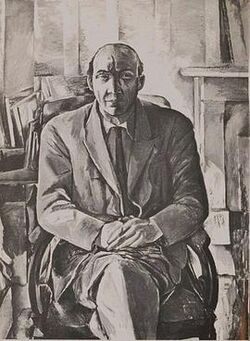George Barker (poet) facts for kids
Quick facts for kids
George Barker
|
|
|---|---|

George Barker, by Patrick Swift, c. 1960
|
|
| Born | 26 February 1913 Loughton, Essex, England |
| Died | 27 October 1991 (aged 78) Itteringham, Norfolk, England |
| Occupation | Poet |
| Nationality | English |
| Education | Regent Street Polytechnic |
George Granville Barker (born February 26, 1913 – died October 27, 1991) was an English poet. He was part of a group called the New Apocalyptics. This group liked to write about myths and dreams, instead of just real-life events. His connection with writer Elizabeth Smart inspired her famous book, By Grand Central Station I Sat Down and Wept.
Contents
Early Life and Education
George Barker was born in Loughton, Essex, England. His father, George Barker, was a police officer. His mother, Marion Frances, came from Ireland. When George was six months old, his family moved to Chelsea. He grew up in Battersea, London, and later lived in Holland Park.
Barker went to a school run by the London County Council. He also studied at Regent Street Polytechnic. He left school quite young. Before becoming a writer, he worked at several different jobs.
Start of a Writing Career
Barker started writing early in his life. Some of his first books of poems include Thirty Preliminary Poems (1933) and Poems (1935). His book Calamiterror (1937) was inspired by the Spanish Civil War. In this book, he wrote against the Spanish Nationalists.
When he was in his early twenties, a famous publisher, T.S. Eliot at Faber and Faber, published his work. This helped him get a job as a Professor of English Literature. In 1939, he started teaching at Tohoku University in Sendai, Miyagi, Japan. He wrote Pacific Sonnets while he was there. He left Japan in 1940 because of the war.
Later Life and Works
After leaving Japan, Barker traveled to the United States. There, he met writer Elizabeth Smart. They had a relationship that inspired Smart's well-known novel. Barker later returned to England in 1943.
From the late 1960s until he passed away, Barker lived in Itteringham, Norfolk. He lived there with his wife, Elspeth Barker, who was also a writer and journalist. In 1969, he published a poem called At Thurgarton Church. The village of Thurgarton is close to Itteringham.
Barker's 1950 novel, The Dead Seagull, also described his relationship with Elizabeth Smart. Robert Fraser put together Barker's Collected Poems (ISBN: 0-571-13972-8). This collection was published in 1987 by Faber and Faber.
Writing Style and Legacy
George Barker was connected to the New Apocalyptics movement. This group of writers liked to use themes of myths and dreams in their work. They were different from writers in the 1930s who focused more on real-life events. However, Barker also had his own unique style that made him stand out.
Some people thought Barker's writing could be uneven. But C.H. Sisson believed that Barker's best work was The True Confession of George Barker.
It was said that Barker made it hard for people to write about his life. He once said, "I've stirred the facts around too much... It simply can't be done." However, Robert Fraser did write a biography about him. It was called The Chameleon Poet: A Life of George Barker and came out in 2001.

